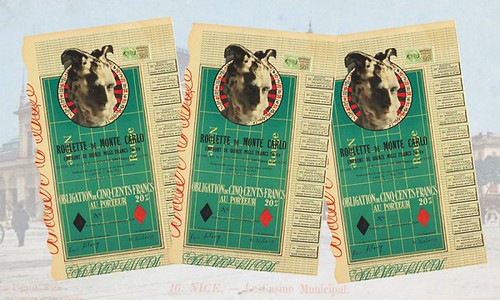
We've discusses this money-themed artwork before - Marcel Duchamp's Monte Carlo Bond. Here's a new article from the MIT Press Reader.
Also found via News & Notes from the Society of Paper Money Collectors (Volume IX, Number 3, July 4, 2023).
-Editor

What was one of the most radical artists of the 20th century doing playing roulette in the casinos of Monte Carlo? And why did he insist, as he honed his complex gambling system, armed with capital from a risky financial scheme, that I haven't stopped being a painter, now I draw on chance ? This article is drawn from my book on the importance of the poet Stéphane Mallarmé for debates among European avant-garde artists about chance, the nature of language, and the hazards of communication. While the full chapter argues that Duchamp had Mallarmé's impossible dream of abolishing chance in mind as he confronted the incipient financialization of art, this excerpt lays out Duchamp's strategy to break the bank in Monte Carlo and his quixotic hope to render roulette into a game of chess.
On November 1, 1924, Marcel Duchamp issued his Monte Carlo Bond, a limited-edition artwork and bearer bond (obligation au porteur as it is written on the front of the work), which is to say, a legal agreement that could be traded and spent like paper money.
As though advertising its split identity, the bond identified Duchamp's female alter ego, Rrose Sélavy, as the President of the Administrative Council and relegated him to the role of her Administrator. The reverse of the bond provided the statues of Sélavy's joint-stock company and some basic information about its aims: The goal of the company is… Exploitation of Roulette in Monte Carlo under the conditions listed below… The annual payment is based upon a cumulative system [système à montant], experimentally tested through 100,000 rolls of the ball, which is exclusive property of the Administrative Council.
The stated purpose of its production and sale was to raise capital to fund Duchamp's deployment of his roulette system. He initially intended to sell 30 Monte Carlo Bonds, but it seems that only eight were produced — and even fewer sold. The nature of the sale, what it meant to purchase one of the works, was one of its greatest paradoxes: On the one hand, it was a limited-edition print and artwork; on the other, it was made, quite seriously it seems, as a bearer bond, a financial instrument entitling its purchaser to be paid interest on their investment at a rate of 20 percent.
These two modes entail radically different aesthetic, economic, and power relations between buyer and seller, yet they were fused in this one object, in which the artist was both source of aesthetic value and debtor, and the buyer was both collector and creditor. Whether conceived as a critique of the art market or as a shrewd financial arrangement, Duchamp's Bond appears extraordinary prescient from the vantage point of the 21st century, when debt drives the financialization of social relations and works of art are sheltered from their public value (as objects made to be beheld or as taxable assets) in Freeport storage vaults, to be glimpsed only at the moment of exchange.
Man Ray, who visited Duchamp in Nice and accompanied him to the casinos on at least one occasion, ... recalled that Duchamp studied the monthly sheets of all the numbers that came up, published by Monte Carlo, and worked out a system of placing his money that would infallibly bring in a return profit. And, later, Duchamp specified that he was exploiting a Martingale to break the bank in Monte Carlo, but continued: Unfortunately, the system is too slow to have a practical value. I often had to wait over half an hour for the numbers to appear in the succession of reds and blacks and the weeks I spent in Monte Carlo were so boring that I soon abandoned it, happy to emerge without a loss.
Duchamp's art was far more successful than his foray into gambling - in 2010 Christie's sold one of these works for over $1 million.
-Editor
To read the complete article, see:
Marcel Duchamp, the Gambler
(https://thereader.mitpress.mit.edu/marcel-duchamp-the-gambler/)
To read the earlier E-Sylum article, see:
MARCEL DUCHAMP'S MONTE CARLO BOND NO 1
(https://www.coinbooks.org/esylum_v14n05a20.html)
WALL STREET'S CRYPTO ARTIST
(https://www.coinbooks.org/v24/esylum_v24n22a24.html)
Wayne Homren, Editor
The Numismatic Bibliomania Society is a non-profit organization
promoting numismatic literature. See our web site at coinbooks.org.
To submit items for publication in The E-Sylum, write to the Editor
at this address: whomren@gmail.com
To subscribe go to: https://my.binhost.com/lists/listinfo/esylum
Copyright © 1998 - 2024 The Numismatic Bibliomania Society (NBS)
All Rights Reserved.
NBS Home Page
Contact the NBS webmaster
|



